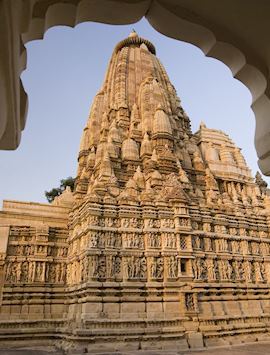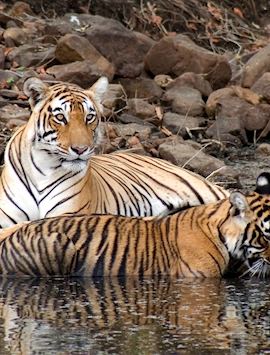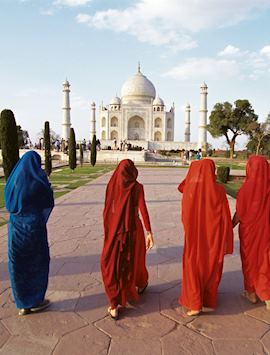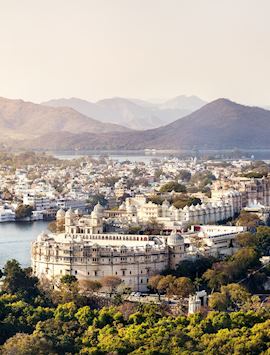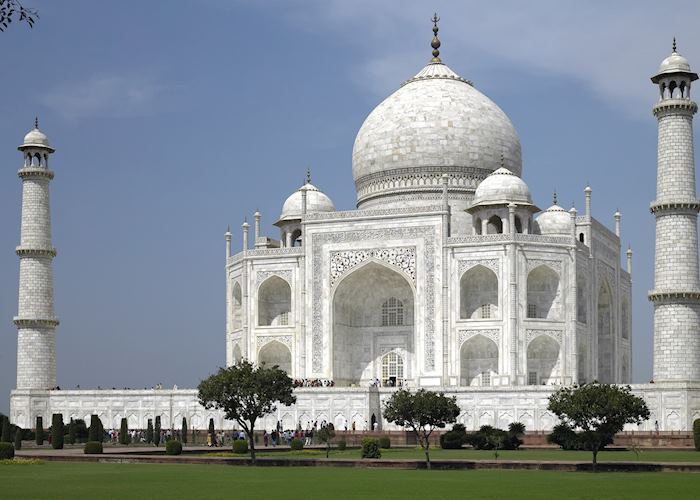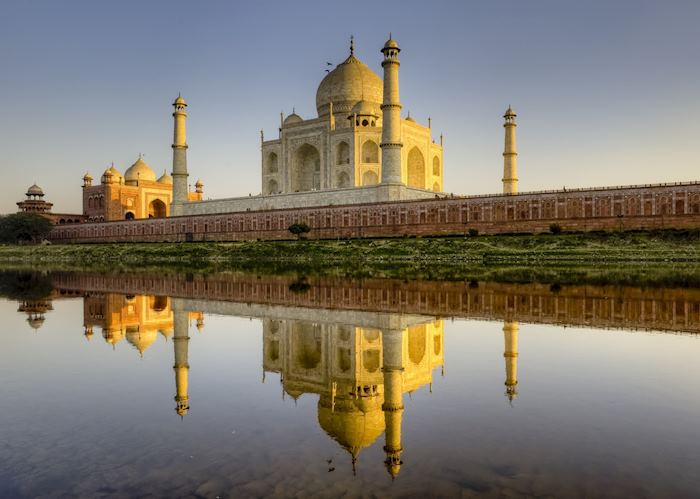Jump to:
Most famous as the home of the Taj Mahal, Agra is set on a bend in the sacred Yamuna River and has held a strategic defensive position throughout its history. Both the Taj and the highly impressive city fort overlook the river, as do a number of significant tombs and mausoleums from the Mughal period. The Taj is the undoubted highlight, a magnificent structure that easily lives up to its exalted reputation. Modern Agra by comparison lacks the charm of the other great cities of India's north, however its exquisite monuments make it an unmissable stop on any first time tour of the country.
India specialist HannahWhilst the Taj Mahal is an obvious must-see in the chaotic city of Agra, the Tomb of Itimad-ud-Daulah, known as the ‘Baby Taj’ is a fascinating addition. It’s said to be the mini draft of the Taj itself.
Things to see and do in Agra
The Taj Mahal
 One of the world's most famous buildings, the Taj Mahal, which means Crown Palace, is every bit as impressive in real life as it is in carefully-posed pictures. As you enter through an elaborate arched gateway you will see the monument for the first time, the wonderfully symmetrical landscaped gardens leading your eye to the intricately carved marble domes and towers. An extravagant memorial to Emperor Shah Jahan’s beloved third wife, it took thousands of artisans over 20 years to construct and its timeless beauty is a testament to their skill and vision. Sunrise and sunset are the best times to visit, when there are fewer visitors and the soft light bathes the building in a romantic glow.
One of the world's most famous buildings, the Taj Mahal, which means Crown Palace, is every bit as impressive in real life as it is in carefully-posed pictures. As you enter through an elaborate arched gateway you will see the monument for the first time, the wonderfully symmetrical landscaped gardens leading your eye to the intricately carved marble domes and towers. An extravagant memorial to Emperor Shah Jahan’s beloved third wife, it took thousands of artisans over 20 years to construct and its timeless beauty is a testament to their skill and vision. Sunrise and sunset are the best times to visit, when there are fewer visitors and the soft light bathes the building in a romantic glow.
The Red Fort
A magnificent 16th century fortress with 20 metre high walls, the Red Fort is a vast sandstone complex which was converted into a lavish palace by Shah Jahan. It remains one of the finest Mughal forts in India and a collection of impressive buildings can be seen inside. There are several mosques, including the exquisite Nagina Masjid, originally used by the ladies of the court. You will also pass through several public halls used for audiences with the public or visiting dignitaries, the elaborate Mirror Palace, and a white marble tower where Shah Jahan was imprisoned for eight years by his son.
The Baby Taj
The Itimad-ud-Daulah is a lavish 17th century tomb which houses the mausoleum of Mirza Ghiyas Beg and his family. Sometimes called the 'Baby Taj' by local guides, it is located in a very tranquil area and was the first building in the city to be clad entirely in marble. Although far smaller than the Taj Mahal, it is exquisite in its detail with extremely delicate carvings and elaborate architectural flourishes. Four corner minarets surround a rooftop pavilion, intricate inlay work completely covers the structure, and a superbly carved latticework wall screens the tombs from initial view.
Kachhpura village walk
Overlooking the Taj Mahal from the opposite bank of the Yamuna River, Kachhpura village is near a number of ancient Mughal monuments including the Gyarah Sidi and Humayun's Mosque. Walking tours here are run as part of a community development programme with local people trained as tour guides. Leading you around their own village, they offer authentic insights into life in this rural setting and will guide you around the main sights as well as introducing you to several members of the village. The walk ends at Mehtab Bagh, from where there are majestic views across the river to the Taj Mahal.
who's been there
-
01993 838 92501993 838 345
- Make an enquiry
Suggested itineraries featuring Agra
Our itineraries will give you suggestions for what is possible when you travel in Agra, and they showcase routes we know work particularly well. Treat them as inspiration, because your trip will be created uniquely by one of our specialists.
Places near Agra
- Fatehpur Sikri 23 miles away
- Bharatpur and Keoladeo Ghana National Park 33 miles away
- Chambal Sanctuary 44 miles away
- Gwalior 69 miles away
- Ramathra 99 miles away
- Delhi 112 miles away
- Ranthambhore National Park 124 miles away
- Orchha 133 miles away
- Samode 135 miles away
- Jaipur 136 miles away
- Corbett Tiger Reserve 173 miles away
- Nainital 177 miles away
- Bundi 190 miles away
- Haridwar 192 miles away
- Almora 196 miles away
- Khajuraho 201 miles away
- Rishikesh 204 miles away
- Bhainsrorgarh 217 miles away
- Panna National Park 218 miles away
- Pushkar 219 miles away
- Shahpura 220 miles away
- Barli 221 miles away
- Mussoorie 227 miles away
- Chhatra Sagar 258 miles away
- Nimaj 258 miles away
- Chittorgarh 263 miles away
- Nagaur 263 miles away
- Shimla 276 miles away
- Deogarh 279 miles away
- Bikaner 294 miles away
Photos of Agra
Our expert guides to exploring Agra
Written by our specialists from their own experiences of visiting Agra, these guides will help you make the most of your time there. We share both our practical recommendations and the best ways to appreciate Agra at its best.
-
What to do in India: our highlights guide ![Sadhu in Varanasi]()
What to do in India: our highlights guide
What to do in India: our highlights guide
Our India specialists pick some of their best things to see and do, and where to stay from the Himalaya to Kerala. Include spotting tiger, staying in a palace in Rajasthan, taking a boat trip down the Ganges and experience one of the country’s many festivals in your trip to India.
Read this guide -
Touring India’s Golden Triangle ![Hawa Mahal in Jaipur]()
Touring India’s Golden Triangle
Touring India’s Golden Triangle
The Taj Mahal is just one of many impressive sights on a tour of India’s Golden Triangle. For first-time visitors, the region offers a tempting taste of the vast range of cultures, historical sites, architecture, religion, food and landscapes that India boasts.
Read this guide -
Luxury rail journeys through India ![Narrow-gauge railway near Darjeeling]()
Luxury rail journeys through India
Luxury rail journeys through India
India specialist and former Mumbai resident Alison shares her experiences of luxury train journeys in India. She has picked out some of the most interesting routes and explains why they’re a fascinating way to explore India.
Read this guide
Accommodation choices for Agra
We've selected a range of accommodation options for when you visit Agra. Our choices usually come recommended for their character, facilities and service or location. Our specialists always aim to suggest properties that match your preferences.
-
![Pool, Trident Agra]()
Trident Agra
Agra -
![Amarvilas, Agra]()
The Oberoi Amarvilas
Agra -
![Pool at the Taj View]()
Tajview
Agra -
![Coral Tree Homestay]()
Coral Tree Homestay
Agra
Ideas for experiencing Agra
Our specialists seek out authentic ways to get to know the places that could feature in your trip. These activities reflect some of the experiences they've most enjoyed while visiting Agra, and which use the best local guides.
-
Taj Mahal at sunrise ![Sunrise at the Taj Mahal, Agra]()
Taj Mahal at sunrise
Taj Mahal at sunrise
The principal reason for almost everyone’s visit to Agra is to see the Taj Mahal. You’ll go in the morning, when it’s less crowded and you can find a peaceful spot to admire it from.
View details



